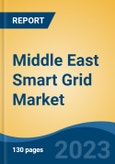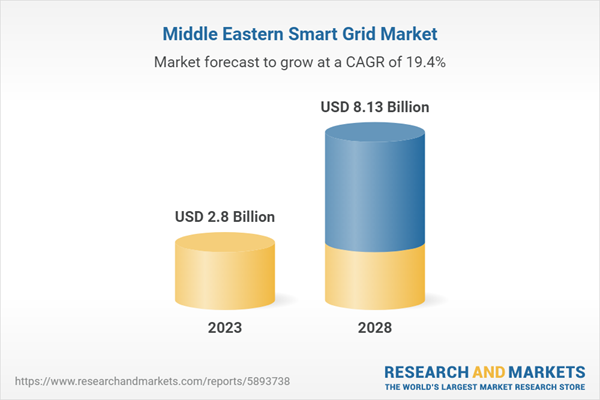Free Webex Call
The Middle East Smart Grid Market is anticipated to grow at a steady pace in the forecast period, 2024-2028. These grids provide technologies that improve fault detection and enable the self-healing of the network automatically, owing to it, the Middle East Smart Grid Market is expected to grow in the forecast period. Speak directly to the analyst to clarify any post sales queries you may have.
10% Free customizationThis report comes with 10% free customization, enabling you to add data that meets your specific business needs.
The term "smart grid" refers to an electrical grid with automation, communication, and information technology systems that can track electrical power from places of supply to points of consumption (even down to the level of individual appliances) and manage the power flow or reduce the load to match generation in real-time or almost real-time.
Increasing investments in Smart Meters Installation in the Middle East
The connection between energy consumers and energy suppliers is represented by smart meters, which are the most significant essential part of the future smart grid. With the use of this smart grid link, customers, suppliers, and load control at the consumer's location are all going to receive fast. The Middle East, particularly Saudi Arabia and the United Arab Emirates, are expected to take over the regional market, due to their growing economy and rising adoption of technology. The need for smart meters is being driven by the rising per-person power usage. As of 2021, DEWA (Dubai Electricity & Water Authority) has installed 2 million smart meters that are checked and read remotely every 15 minutes. As a result, DEWA managed to boost the availability of meter readings to 99.9%, with most meters being remotely invoiced on the SAP platform.Additionally, in February 2022, the Dubai Supreme Council of Energy announced its intention to reduce the region's carbon emission by 30% by 2030. The nation has put in place a number of efforts to help it achieve this goal, including the creation of green construction rules, the creation of behavioral control systems for gadgets, cost-effective slab energy pricing, and public education. Therefore, such measures are anticipated to encourage the installation of smart meters, which in turn drives the market for smart grids in the Middle East.
To support Dubai's efforts to become the one of the world's developed city, smart metres have been carried out through an integrated strategy known as DEWA's (Dubai Electricity and Water Authority) which include "Smart Applications via. Smart Grid and Metres" initiative. The strategy includes a number of initiatives to enhance energy management by financial investments in endeavors with a maximum value of AED 7 billion (USD 1.91 Billion), with completion dates in the near, medium, and long periods through 2035. Therefore, during the anticipated period, such investments are projected to fuel the middle east smart grid market.
Increasing Renewable Energy Deployment
The smart grid industry is anticipated to be significantly impacted by rising investment in renewable energy systems over the projected period. The Middle East has made major investments in solar energy in recent years, in an effort to transition away from energy production from traditional energy sources like crude oil and natural gas. Utilizing the smart grid is essential to ensuring a consistent supply of power due to the region's growing integration of renewable energy sources. Renewable energy systems can occasionally provide erratic amounts of power. The Middle East Solar Industry Association (MESIA) predicts that through 2035, the region's electricity consumption would increase by 3.3% annually, but population growth will be much more rapid. The general population growth rate for nations like Kuwait, Oman, Qatar, Saudi Arabia, and the United Arab Emirates is 3.5%.Additionally, by 2030, Dubai aims to have 5% of its power generation come from renewable sources, up from 1% in 2020. Besides that, by the end of 2030, Dubai's aim is to decrease overall energy usage by 30%. According to the International Renewable Energy Agency (IRENA), from 2015 to 2020, solar PV technology costs fell by 58%. For its first large-scale solar installation, Saudi Arabia saw the lowest rates proposed. There has been an increase in interest in the green energy industry as a result of solar power tariffs in some regions reaching cost parity with conventional fuels. By the end of 2035, it is anticipated that the Middle Eastern area would have added around 61 GW of additional solar generating capacity. By the fourth quarter of 2035, the MESIA projects that the Middle East will require 277 GW of new capacity to bring its existing capacity to 483 GW because of rising demand. As a result, the Middle East's market for smart grids is anticipated to be driven by the region's growing integration of renewable energy sources into its power consumption throughout the period of forecasting.
Major Smart Meter Installation Projects in the Region
Middle east countries are focusing on smart grid since high demand of electricity generation is required in the region. The following are some examples of the latest Smart Meter Installation Projects.- In April 2021, over 10 million smart meters have been successfully installed in Saudi Arabia as part of the Smart Metering Project, which was launched nationwide. With a strong emphasis on energy efficiency and power savings, the project has prepared the way for the implementation of smart grid infrastructure in the area.
- To digitalize the country's electrical network, Kahramaa, Qatar's general electricity and water organization, mentioned in December 2021 that it has successfully finished the country's smart meter communications networks.
- By the end of 2023, Qatar's effort to install 600,000 smart metres nationwide is expected to be complete. When the project is completely carried out, it is anticipated that the smart metres would improve the utility company's dependability and the efficiency of the metre readings, resulting in cost savings of up to 10% for the utility and the consumers.
- The announcement of the United Arab Emirates' Net-Zero by 2050, Strategic Initiative in October 2021 made it the first Middle Eastern nation to declare its ambition to attain net-zero emissions. The strategy is for investing 600 billion AED (USD 163.36 Billion) in renewable energy. Furthermore, the government hopes to have roughly 14 GW of installed renewable energy by 2030.
- Kuwait aims to generate 15% of its power from renewable sources by 2030. Additionally, in the next several years, the government intends to install roughly 800,000 smart metres to modernize the electrical grid infrastructure. In addition, the government is cutting energy usage by 30% while 15% generation efficiency improvements are made to its power plants.
- According to the government of Oman, it aims to generate 16% of its power from renewable sources by 2025 and 30% by 2030. In addition, Oman wants to decrease the rise of GHG emissions and cut emissions by 7% in 2030. The government declared in 2021 that it will install 1.2 million smart metres nationally during the next five years to enhance the electricity infrastructure.
Market Segmentation
The Middle East smart grid market is segmented based on components, application, end user, and country. Based on component, the market is segmented into software and hardware. Based on hardware, the market is sub segmented by sensors, communication equipment, and others. Based on application, the market is segmented into power generation and transmission networks, distribution and advanced metering infrastructure (AMI), and other technology application areas. Based on end user, the market is segmented into industrial, commercial, residential, and utility. Based on country, the market is segmented into Saudi Arabia, UAE, Qatar, Kuwait, Bahrain, and rest of Middle East.Market Players
Major market players in the Middle East smart grid market are Dubai Electricity and Water Authority (DEWA), Abu Dhabi National Energy Company PJSC (Taqa), Alfanar Group, Qatar General Water & Electricity Corporation (Kahramaa), General Electric Company, Hitachi Energy Ltd, Siemens AG, Landis+Gyr Group AG, EDMI Limited, and Honeywell International Inc.Report Scope:
In this report, the Middle East Smart Grid Market has been segmented into following categories, in addition to the industry trends which have also been detailed below:Middle East Smart Grid Market, By Component:
- Software
- Hardware
- Sensors
- Communication equipment
- Others
Middle East Smart Grid Market, By Application:
- Power Generation and Transmission Networks
- Distribution and Advanced Metering Infrastructure (AMI)
- Other Technology Application Areas
Middle East Smart Grid Market, By End User:
- Industrial
- Commercial
- Residential
- Utility
Middle East Smart Grid Market, by Country:
- Saudi Arabia
- UAE
- Qatar
- Kuwait
- Bahrain
Competitive Landscape
Company Profiles: Detailed analysis of the major companies present in the Middle East Smart Grid Market.Available Customizations:
Middle East Smart Grid Market report with the given market data, the publisher offers customizations according to a company's specific needs.This product will be delivered within 1-3 business days.
Table of Contents
1. Product Overview
2. Research Methodology
5. Middle East Smart Grid Market Outlook
6. Saudi Arabia Smart Grid Market Outlook
7. UAE Smart Grid Market Outlook
8. Qatar Smart Grid Market Outlook
9. Kuwait Smart Grid Market Outlook
10. Bahrain Smart Grid Market Outlook
11. Market Dynamics
14. Company Profiles
Companies Mentioned
- Dubai Electricity and Water Authority (DEWA)
- Abu Dhabi National Energy Company PJSC (Taqa)
- Alfanar Group
- Qatar General Water & Electricity Corporation (Kahramaa)
- General Electric Company
- Hitachi Energy Ltd
- Siemens AG
- Landis + Gyr Group AG
- EDMI Limited
- Honeywell International Inc.
Table Information
| Report Attribute | Details |
|---|---|
| No. of Pages | 130 |
| Published | October 2023 |
| Forecast Period | 2023 - 2028 |
| Estimated Market Value ( USD | $ 2.8 Billion |
| Forecasted Market Value ( USD | $ 8.13 Billion |
| Compound Annual Growth Rate | 19.4% |
| Regions Covered | Middle East |
| No. of Companies Mentioned | 10 |









